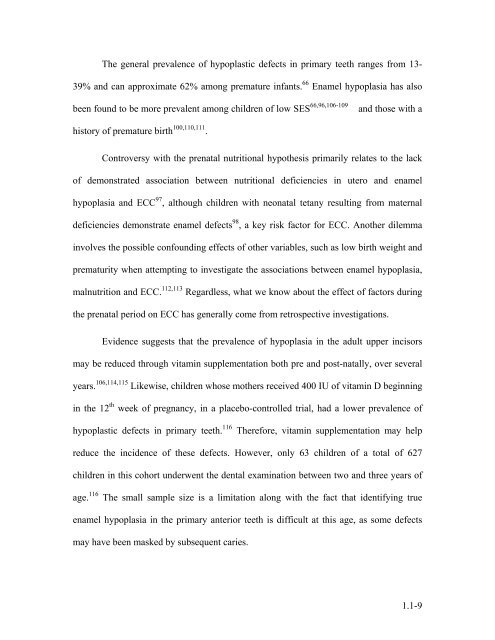Influence of Maternal Prenatal Vitamin D Status on Infant Oral Health
Influence of Maternal Prenatal Vitamin D Status on Infant Oral Health
Influence of Maternal Prenatal Vitamin D Status on Infant Oral Health
You also want an ePaper? Increase the reach of your titles
YUMPU automatically turns print PDFs into web optimized ePapers that Google loves.
The general prevalence <str<strong>on</strong>g>of</str<strong>on</strong>g> hypoplastic defects in primary teeth ranges from 13-<br />
39% and can approximate 62% am<strong>on</strong>g premature infants. 66 Enamel hypoplasia has also<br />
been found to be more prevalent am<strong>on</strong>g children <str<strong>on</strong>g>of</str<strong>on</strong>g> low SES 66,96,106-109<br />
and those with a<br />
history <str<strong>on</strong>g>of</str<strong>on</strong>g> premature birth 100,110,111 .<br />
C<strong>on</strong>troversy with the prenatal nutriti<strong>on</strong>al hypothesis primarily relates to the lack<br />
<str<strong>on</strong>g>of</str<strong>on</strong>g> dem<strong>on</strong>strated associati<strong>on</strong> between nutriti<strong>on</strong>al deficiencies in utero and enamel<br />
hypoplasia and ECC 97 , although children with ne<strong>on</strong>atal tetany resulting from maternal<br />
deficiencies dem<strong>on</strong>strate enamel defects 98 , a key risk factor for ECC. Another dilemma<br />
involves the possible c<strong>on</strong>founding effects <str<strong>on</strong>g>of</str<strong>on</strong>g> other variables, such as low birth weight and<br />
prematurity when attempting to investigate the associati<strong>on</strong>s between enamel hypoplasia,<br />
malnutriti<strong>on</strong> and ECC. 112,113 Regardless, what we know about the effect <str<strong>on</strong>g>of</str<strong>on</strong>g> factors during<br />
the prenatal period <strong>on</strong> ECC has generally come from retrospective investigati<strong>on</strong>s.<br />
Evidence suggests that the prevalence <str<strong>on</strong>g>of</str<strong>on</strong>g> hypoplasia in the adult upper incisors<br />
may be reduced through vitamin supplementati<strong>on</strong> both pre and post-natally, over several<br />
years. 106,114,115 Likewise, children whose mothers received 400 IU <str<strong>on</strong>g>of</str<strong>on</strong>g> vitamin D beginning<br />
in the 12 th week <str<strong>on</strong>g>of</str<strong>on</strong>g> pregnancy, in a placebo-c<strong>on</strong>trolled trial, had a lower prevalence <str<strong>on</strong>g>of</str<strong>on</strong>g><br />
hypoplastic defects in primary teeth. 116 Therefore, vitamin supplementati<strong>on</strong> may help<br />
reduce the incidence <str<strong>on</strong>g>of</str<strong>on</strong>g> these defects. However, <strong>on</strong>ly 63 children <str<strong>on</strong>g>of</str<strong>on</strong>g> a total <str<strong>on</strong>g>of</str<strong>on</strong>g> 627<br />
children in this cohort underwent the dental examinati<strong>on</strong> between two and three years <str<strong>on</strong>g>of</str<strong>on</strong>g><br />
age. 116 The small sample size is a limitati<strong>on</strong> al<strong>on</strong>g with the fact that identifying true<br />
enamel hypoplasia in the primary anterior teeth is difficult at this age, as some defects<br />
may have been masked by subsequent caries.<br />
1.1-9







![an unusual bacterial isolate from in partial fulf]lment for the ... - MSpace](https://img.yumpu.com/21942008/1/190x245/an-unusual-bacterial-isolate-from-in-partial-fulflment-for-the-mspace.jpg?quality=85)





![in partial fulfil]ment of the - MSpace - University of Manitoba](https://img.yumpu.com/21941988/1/190x245/in-partial-fulfilment-of-the-mspace-university-of-manitoba.jpg?quality=85)


